Sanath Narayan
From Unimodal to Multimodal: Scaling up Projectors to Align Modalities
Sep 28, 2024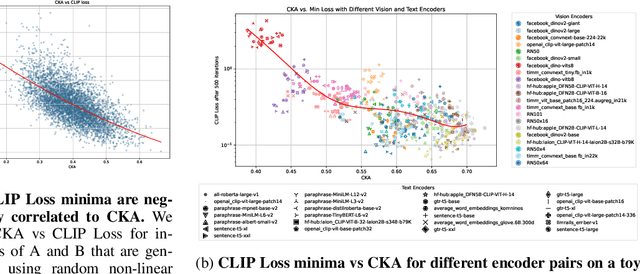
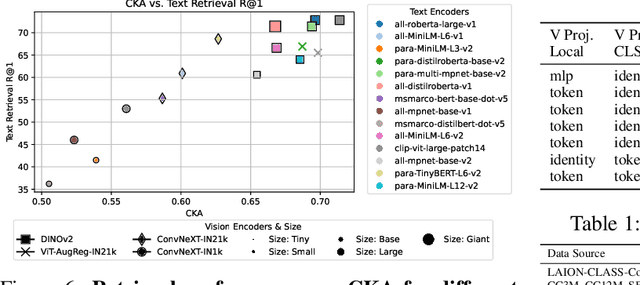
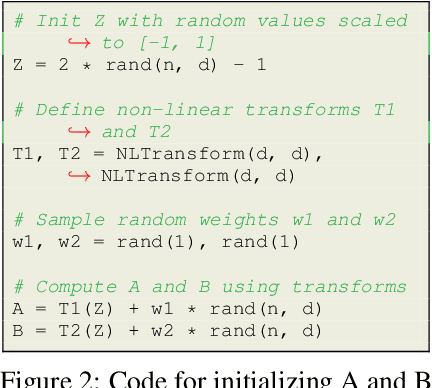
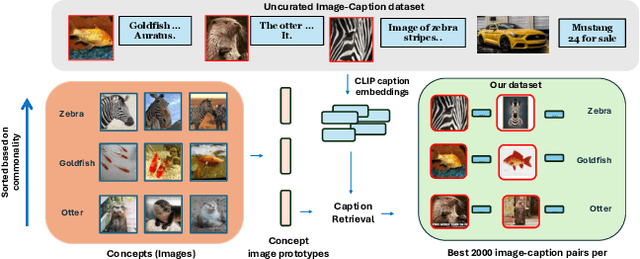
Abstract:Recent contrastive multimodal vision-language models like CLIP have demonstrated robust open-world semantic understanding, becoming the standard image backbones for vision-language applications due to their aligned latent space. However, this practice has left powerful unimodal encoders for both vision and language underutilized in multimodal applications which raises a key question: Is there a plausible way to connect unimodal backbones for zero-shot vision-language tasks? To this end, we propose a novel approach that aligns vision and language modalities using only projection layers on pretrained, frozen unimodal encoders. Our method exploits the high semantic similarity between embedding spaces of well-trained vision and language models. It involves selecting semantically similar encoders in the latent space, curating a concept-rich dataset of image-caption pairs, and training simple MLP projectors. We evaluated our approach on 12 zero-shot classification datasets and 2 image-text retrieval datasets. Our best model, utilizing DINOv2 and All-Roberta-Large text encoder, achieves 76\(\%\) accuracy on ImageNet with a 20-fold reduction in data and 65 fold reduction in compute requirements. The proposed framework enhances the accessibility of model development while enabling flexible adaptation across diverse scenarios, offering an efficient approach to building multimodal models by utilizing existing unimodal architectures. Code and datasets will be released soon.
Falcon2-11B Technical Report
Jul 20, 2024



Abstract:We introduce Falcon2-11B, a foundation model trained on over five trillion tokens, and its multimodal counterpart, Falcon2-11B-vlm, which is a vision-to-text model. We report our findings during the training of the Falcon2-11B which follows a multi-stage approach where the early stages are distinguished by their context length and a final stage where we use a curated, high-quality dataset. Additionally, we report the effect of doubling the batch size mid-training and how training loss spikes are affected by the learning rate. The downstream performance of the foundation model is evaluated on established benchmarks, including multilingual and code datasets. The foundation model shows strong generalization across all the tasks which makes it suitable for downstream finetuning use cases. For the vision language model, we report the performance on several benchmarks and show that our model achieves a higher average score compared to open-source models of similar size. The model weights and code of both Falcon2-11B and Falcon2-11B-vlm are made available under a permissive license.
Open-Vocabulary Temporal Action Localization using Multimodal Guidance
Jun 21, 2024Abstract:Open-Vocabulary Temporal Action Localization (OVTAL) enables a model to recognize any desired action category in videos without the need to explicitly curate training data for all categories. However, this flexibility poses significant challenges, as the model must recognize not only the action categories seen during training but also novel categories specified at inference. Unlike standard temporal action localization, where training and test categories are predetermined, OVTAL requires understanding contextual cues that reveal the semantics of novel categories. To address these challenges, we introduce OVFormer, a novel open-vocabulary framework extending ActionFormer with three key contributions. First, we employ task-specific prompts as input to a large language model to obtain rich class-specific descriptions for action categories. Second, we introduce a cross-attention mechanism to learn the alignment between class representations and frame-level video features, facilitating the multimodal guided features. Third, we propose a two-stage training strategy which includes training with a larger vocabulary dataset and finetuning to downstream data to generalize to novel categories. OVFormer extends existing TAL methods to open-vocabulary settings. Comprehensive evaluations on the THUMOS14 and ActivityNet-1.3 benchmarks demonstrate the effectiveness of our method. Code and pretrained models will be publicly released.
Efficient 3D-Aware Facial Image Editing via Attribute-Specific Prompt Learning
Jun 06, 2024Abstract:Drawing upon StyleGAN's expressivity and disentangled latent space, existing 2D approaches employ textual prompting to edit facial images with different attributes. In contrast, 3D-aware approaches that generate faces at different target poses require attribute-specific classifiers, learning separate model weights for each attribute, and are not scalable for novel attributes. In this work, we propose an efficient, plug-and-play, 3D-aware face editing framework based on attribute-specific prompt learning, enabling the generation of facial images with controllable attributes across various target poses. To this end, we introduce a text-driven learnable style token-based latent attribute editor (LAE). The LAE harnesses a pre-trained vision-language model to find text-guided attribute-specific editing direction in the latent space of any pre-trained 3D-aware GAN. It utilizes learnable style tokens and style mappers to learn and transform this editing direction to 3D latent space. To train LAE with multiple attributes, we use directional contrastive loss and style token loss. Furthermore, to ensure view consistency and identity preservation across different poses and attributes, we employ several 3D-aware identity and pose preservation losses. Our experiments show that our proposed framework generates high-quality images with 3D awareness and view consistency while maintaining attribute-specific features. We demonstrate the effectiveness of our method on different facial attributes, including hair color and style, expression, and others. Code: https://github.com/VIROBO-15/Efficient-3D-Aware-Facial-Image-Editing.
Multi-modal Generation via Cross-Modal In-Context Learning
May 28, 2024

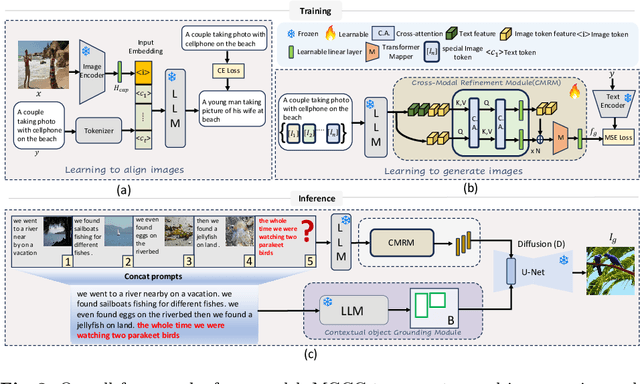

Abstract:In this work, we study the problem of generating novel images from complex multimodal prompt sequences. While existing methods achieve promising results for text-to-image generation, they often struggle to capture fine-grained details from lengthy prompts and maintain contextual coherence within prompt sequences. Moreover, they often result in misaligned image generation for prompt sequences featuring multiple objects. To address this, we propose a Multi-modal Generation via Cross-Modal In-Context Learning (MGCC) method that generates novel images from complex multimodal prompt sequences by leveraging the combined capabilities of large language models (LLMs) and diffusion models. Our MGCC comprises a novel Cross-Modal Refinement module to explicitly learn cross-modal dependencies between the text and image in the LLM embedding space, and a contextual object grounding module to generate object bounding boxes specifically targeting scenes with multiple objects. Our MGCC demonstrates a diverse range of multimodal capabilities, like novel image generation, the facilitation of multimodal dialogue, and generation of texts. Experimental evaluations on two benchmark datasets, demonstrate the effectiveness of our method. On Visual Story Generation (VIST) dataset with multimodal inputs, our MGCC achieves a CLIP Similarity score of $0.652$ compared to SOTA GILL $0.641$. Similarly, on Visual Dialogue Context (VisDial) having lengthy dialogue sequences, our MGCC achieves an impressive CLIP score of $0.660$, largely outperforming existing SOTA method scoring $0.645$. Code: https://github.com/VIROBO-15/MGCC
ViSpeR: Multilingual Audio-Visual Speech Recognition
May 27, 2024Abstract:This work presents an extensive and detailed study on Audio-Visual Speech Recognition (AVSR) for five widely spoken languages: Chinese, Spanish, English, Arabic, and French. We have collected large-scale datasets for each language except for English, and have engaged in the training of supervised learning models. Our model, ViSpeR, is trained in a multi-lingual setting, resulting in competitive performance on newly established benchmarks for each language. The datasets and models are released to the community with an aim to serve as a foundation for triggering and feeding further research work and exploration on Audio-Visual Speech Recognition, an increasingly important area of research. Code available at \href{https://github.com/YasserdahouML/visper}{https://github.com/YasserdahouML/visper}.
Do Vision and Language Encoders Represent the World Similarly?
Jan 10, 2024



Abstract:Aligned text-image encoders such as CLIP have become the de facto model for vision-language tasks. Furthermore, modality-specific encoders achieve impressive performances in their respective domains. This raises a central question: does an alignment exist between uni-modal vision and language encoders since they fundamentally represent the same physical world? Analyzing the latent spaces structure of vision and language models on image-caption benchmarks using the Centered Kernel Alignment (CKA), we find that the representation spaces of unaligned and aligned encoders are semantically similar. In the absence of statistical similarity in aligned encoders like CLIP, we show that a possible matching of unaligned encoders exists without any training. We frame this as a seeded graph-matching problem exploiting the semantic similarity between graphs and propose two methods - a Fast Quadratic Assignment Problem optimization, and a novel localized CKA metric-based matching/retrieval. We demonstrate the effectiveness of this on several downstream tasks including cross-lingual, cross-domain caption matching and image classification.
Do VSR Models Generalize Beyond LRS3?
Nov 23, 2023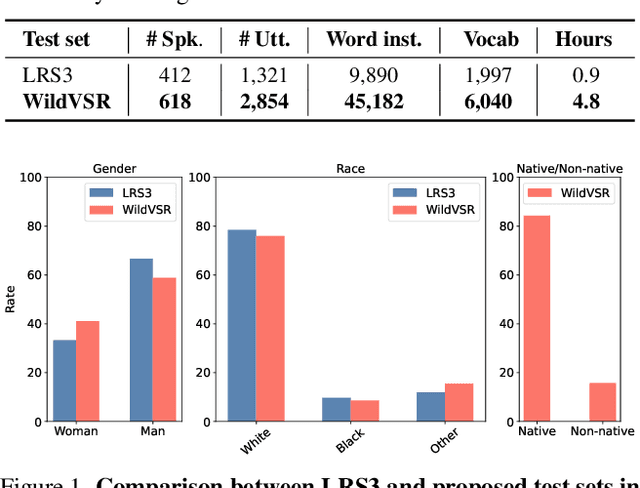
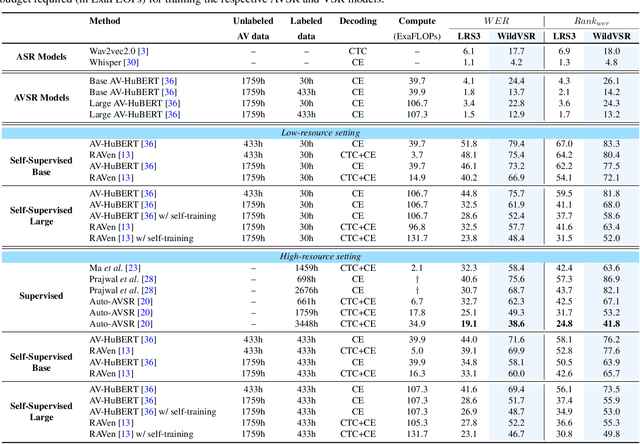
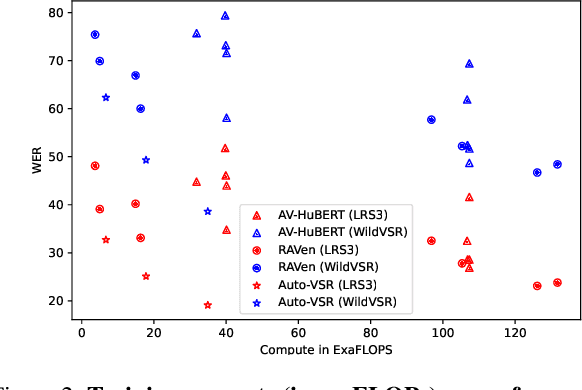
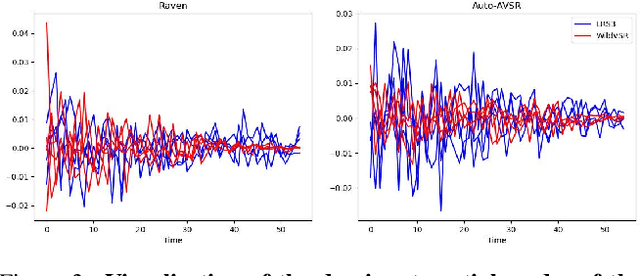
Abstract:The Lip Reading Sentences-3 (LRS3) benchmark has primarily been the focus of intense research in visual speech recognition (VSR) during the last few years. As a result, there is an increased risk of overfitting to its excessively used test set, which is only one hour duration. To alleviate this issue, we build a new VSR test set named WildVSR, by closely following the LRS3 dataset creation processes. We then evaluate and analyse the extent to which the current VSR models generalize to the new test data. We evaluate a broad range of publicly available VSR models and find significant drops in performance on our test set, compared to their corresponding LRS3 results. Our results suggest that the increase in word error rates is caused by the models inability to generalize to slightly harder and in the wild lip sequences than those found in the LRS3 test set. Our new test benchmark is made public in order to enable future research towards more robust VSR models.
Lip2Vec: Efficient and Robust Visual Speech Recognition via Latent-to-Latent Visual to Audio Representation Mapping
Aug 11, 2023Abstract:Visual Speech Recognition (VSR) differs from the common perception tasks as it requires deeper reasoning over the video sequence, even by human experts. Despite the recent advances in VSR, current approaches rely on labeled data to fully train or finetune their models predicting the target speech. This hinders their ability to generalize well beyond the training set and leads to performance degeneration under out-of-distribution challenging scenarios. Unlike previous works that involve auxiliary losses or complex training procedures and architectures, we propose a simple approach, named Lip2Vec that is based on learning a prior model. Given a robust visual speech encoder, this network maps the encoded latent representations of the lip sequence to their corresponding latents from the audio pair, which are sufficiently invariant for effective text decoding. The generated audio representation is then decoded to text using an off-the-shelf Audio Speech Recognition (ASR) model. The proposed model compares favorably with fully-supervised learning methods on the LRS3 dataset achieving 26 WER. Unlike SoTA approaches, our model keeps a reasonable performance on the VoxCeleb test set. We believe that reprogramming the VSR as an ASR task narrows the performance gap between the two and paves the way for more flexible formulations of lip reading.
Remote Sensing Change Detection With Transformers Trained from Scratch
Apr 13, 2023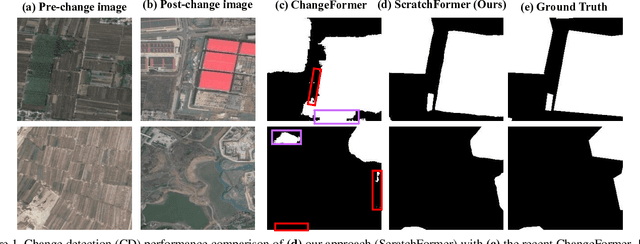

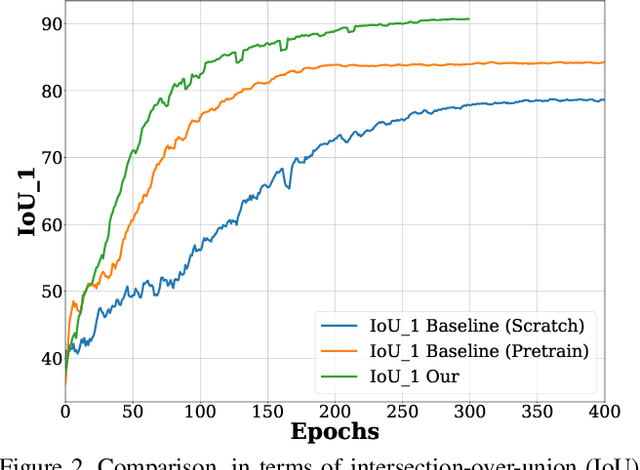

Abstract:Current transformer-based change detection (CD) approaches either employ a pre-trained model trained on large-scale image classification ImageNet dataset or rely on first pre-training on another CD dataset and then fine-tuning on the target benchmark. This current strategy is driven by the fact that transformers typically require a large amount of training data to learn inductive biases, which is insufficient in standard CD datasets due to their small size. We develop an end-to-end CD approach with transformers that is trained from scratch and yet achieves state-of-the-art performance on four public benchmarks. Instead of using conventional self-attention that struggles to capture inductive biases when trained from scratch, our architecture utilizes a shuffled sparse-attention operation that focuses on selected sparse informative regions to capture the inherent characteristics of the CD data. Moreover, we introduce a change-enhanced feature fusion (CEFF) module to fuse the features from input image pairs by performing a per-channel re-weighting. Our CEFF module aids in enhancing the relevant semantic changes while suppressing the noisy ones. Extensive experiments on four CD datasets reveal the merits of the proposed contributions, achieving gains as high as 14.27\% in intersection-over-union (IoU) score, compared to the best-published results in the literature. Code is available at \url{https://github.com/mustansarfiaz/ScratchFormer}.
 Add to Chrome
Add to Chrome Add to Firefox
Add to Firefox Add to Edge
Add to Edge